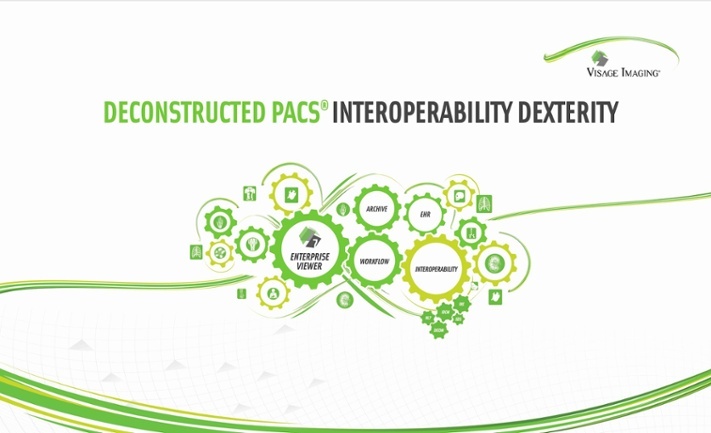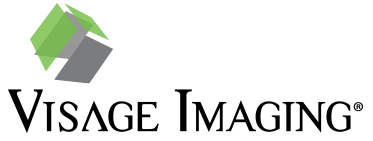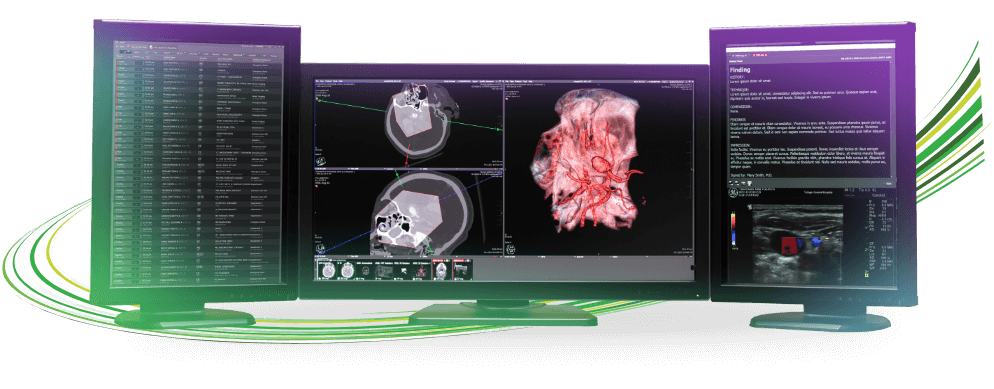Can you? Visage can. Vol. 1 Speed | Chapter 11: Interoperability

We've finally arrived at our last post in our "speed" series of blogs, “Can you? Visage can.” In our last chapter, we discussed how how legacy solutions haven't handled multiple workflows very well, requiring third party software, additional licensing and servers required to support the additional requirements. In contrast, Visage 7's elegant architecture eliminates redundant dataflows, streamling the enterprise imaging infrastructure.
In today’s Imaging environment, interoperability reigns supreme. Radiologists don’t read off of a series of displays in a vacuum, they read in an integrated cockpit. Surrounded by multiple large format, high resolution displays, multiple applications perform an orchestrated ballet in patient context with each and every new study launched. Within a 180 degree glance, the radiologist typically has visual access to their reading worklist, their reporting application, their diagnostic viewer, the EHR, as well as other diagnostic and clinical software applications.
And that brings us to our next topic in Chapter 11: Interoperability.
Interoperability
Interoperability is usually perceived much broader than just the visual fitting of all of the different parts of the radiologist cockpit. In this post I'll be discussing both the desktop user experience and systems interoperability. This is really about the systems speaking “the same language”. Whether it is for visual coordination or information exchange of workflow orchestration, it’s all about knowing the common language and being able to learn the dialects quickly. Concerning interoperability and speed, it is about how long it takes an application to understand what it is being asked to do in the context of the cockpit and how long it takes for the application to react.

The speed of the diagnostic viewer has been addressed in detail over the prior 10 chapters of this series, but it’s also important to recognize the speed and completeness of visual interoperability within the integrated reading cockpit. Fast access to irrelevant information is meaningless. Visage 7's ultrafast speed enables delivery of the information the user needs, when they need it. What I am speaking about is the speed of the first launch and subsequent launches of the diagnostic viewer; speed of closing; the speed of changes in patient context in the diagnostic viewer as directed by other integrated software applications; and the overall speed of the roundtrip from start to finish of an individual interpretation. Based on my travels visiting with numerous institutions, I’ve personally observed lengthy delays when the radiologist cockpit first boots up. Sometimes it takes only a few minutes, other times it shockingly takes 5-10 minutes, or sometimes even more. Due to these delays, radiologists develop interesting habits while they wait!
In addition to being an ultrafast viewer, from our direct observations integrating to most of the major third-party applications in use today, Visage 7 is hands down one of the fastest, if not the fastest software application available. When observing the integrated reading cockpit, you can quickly assess which applications are more lethargic than others, which ones are more responsive, and which ones are downright slow.
As the Dalai Lama of PACS stated 10-years ago in The Dalai Laws of PACS, VI. PACS should not get in your way. For far too many organizations, their legacy viewers and software applications do not easily retain patient context, nor do they all support bi-directional integration. Some applications, including one major EHR manufacturer, only supports a fire-and-forget integration. Others have poor interrupted workflow. And when it comes to speed and productivity, if interoperability is sacrificed, workflow and productivity are bound to be negatively impacted —searching for information; opening this window and that window; verifying information to ensure they are on the right patient. I’m sorry, Dr. Dalai, these subpar solutions definitely get in the way of the reading radiologist. Not good.
In contrast, Visage 7 supports tight bi-directional integration, including to the most widely used EHR, which powers interoperability with both speed and completeness. Radiologists are able to maintain bi-directional, tab-based workflow, easily moving from patient to patient without having to hunt for the clinical information they require or worry about patient context getting out of sync. Robust interoperability improves radiologist confidence, gets them into a reading “zone”, speeds interpretation and improves the quality of interpretation.
Another front end measure of interoperability relates to quality assurance (QA). Many enterprise viewers and VNAs do not support image QA at all, and require yet another third-party solution for QA. And for those that do support image QA, they don’t do it well. Visage 7 supports image QA with the same viewer that also supports all major workflows. In contrast to many legacy PACS that require performing QA on an isolated PC (resulting in technologists that have to complete exams on one PC, and then jump to another PC to perform QA), Visage 7 seamlessly runs on the same PC with multiple applications, including workflow applications and the EHR. This simplifies and speeds technologist QA with an easy workflow that enables technologists to quickly complete their work and confidently move on, so they can spend more time with patients.
From a backend perspective, standards-based integration is absolutely key, leveraging the latest DICOM and HL7 standards, and IHE guidelines. The use of web services and emerging integration approaches such as FHIR are also important to support cutting edge initiatives. One of the most important standards, but only recently beginning to be implemented over the last few years is Imaging Object Change Management (IOCM). IOCM ensures that VNAs and PACS archives communicate automatically with enterprise viewers, such that QA changes automatically are sent to the VNA to stay synchronized. Without IOCM, proprietary approaches are also available. What is shocking is that far too many institutions have invested millions in VNAs, but are still manually making changes on the PACS/enterprise viewer and on their VNA. Really? Really. Talk about an impact to speed and quality, duplicate manual edits on the viewer and VNA are unacceptable in 2017, and a huge drain on enterprise imaging initiatives. Visage 7 fully supports a standards-based approach (HL7, DICOM, IHE, FHIR, IOCM, Web Services), for the most efficient, fastest, most complete enterprise imaging solutions.
Too many legacy vendors pay lip service to interoperability, but usually don’t apply it, because they want to sell more products across their portfolio. For example, many PACS companies say they endorse standards, have open APIs and promote interoperability, but the reality is there are many companies that use terms like “single platform, etc.” because they want to sell more stuff, or their products don’t integrate well at all with other solutions. We've seen this time and again from legacy vendors that will say one thing pre-sales, but do another during implementation. Visage can confidently say that we support standards-based interoperability by way of our large Deconstructed PACS install base. Visage has proven the model, it works.
Summary
And with that, we have now come to the close of the speed series of Visage Blog posts. We’ve repeatedly been posing the question, “Can you? Visage can.” Hopefully you now have a better, more comprehensive understanding of speed in Imaging, and can make a detailed assessment about how your PACS/enterprise viewer(s) are performing. How do your systems stack up?
Speed is critically important across the entire Visage 7 Enterprise Imaging Platform: speed across the dataflows, speed launching Visage 7 independently, or launched from third-party applications in an orchestrated bi-directional interpretation cockpit, speed launching current/prior(s) local or remote, speed for any stud(ies) regardless of size or workflow need. Speed enables access to information, and information is what matters. Fundamentally, Visage 7 provides differentiated value on a scope and scale that competing solutions cannot approach.
Can you? Visage can. Thanks for reading, and please subscribe to the Visage Blog for the latest in Visage insights. While I hope the examples shared have helped to further your understanding of Visage 7, don’t take my word for it. Try Visage 7 out for yourself with a Visage 7 Test Drive today.




